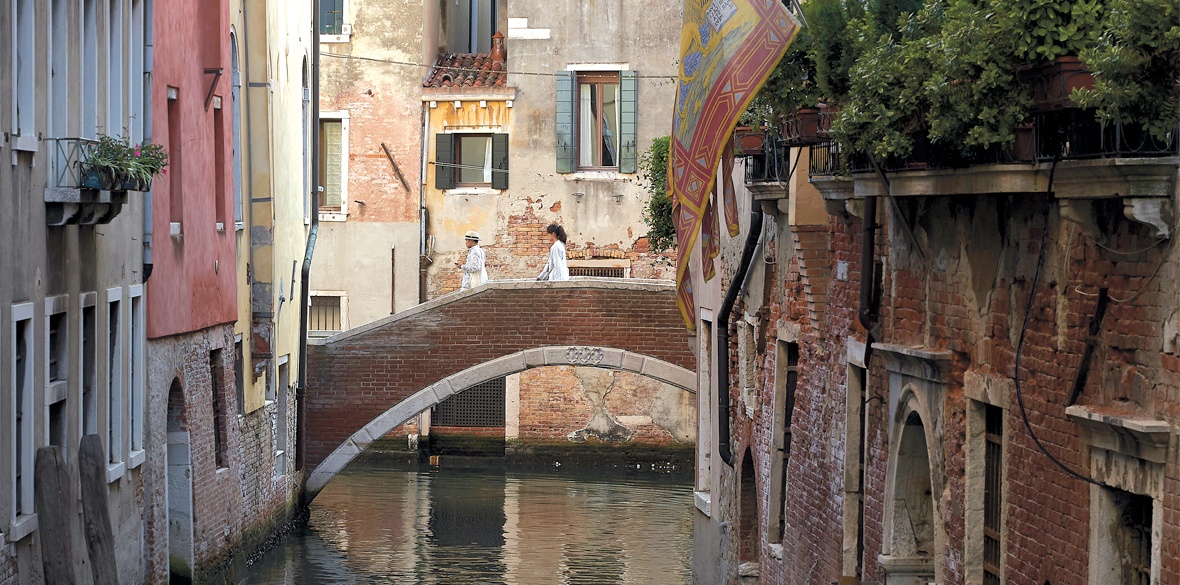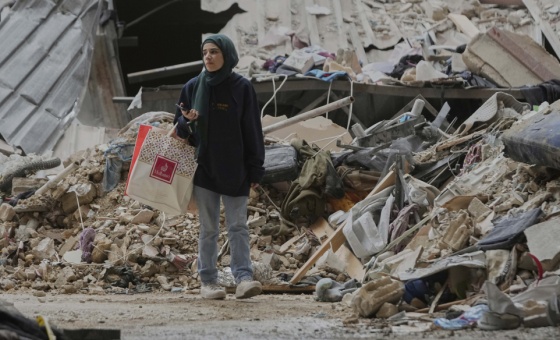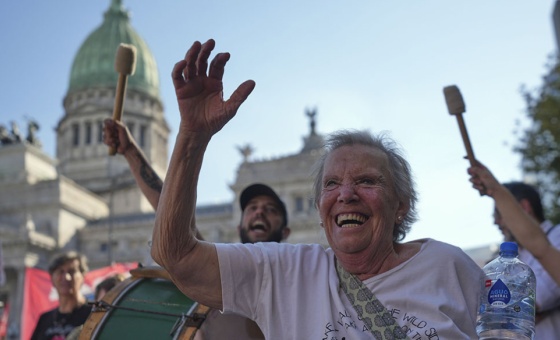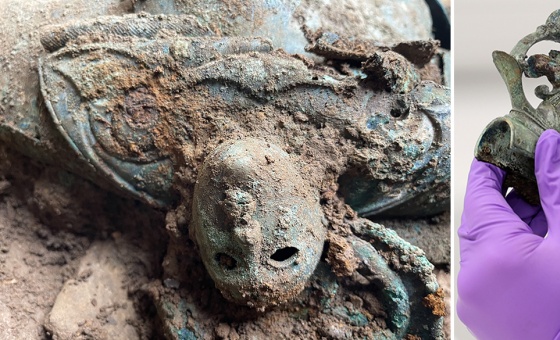This is the last article you can read this month
You can read more article this month
You can read more articles this month
Sorry your limit is up for this month
Reset on:
Please help support the Morning Star by subscribing here
I HAD worked for a few days on the beach, between Malamocco and Alberoni, on that thin strip of land that separates the Adriatic Sea from the lagoon.
A raging storm, which went on all night, had first eroded the beach and then covered it with residual sand, as well as all kinds of debris: a forest of timber, bushes, uprooted trees, dead branches, evergreens, together with a firmament of starfish and shells.
An extraordinary cleaning operation had been necessary. It consisted of manually collecting and piling up all this material which would then be removed with mechanical vehicles by a specialist contractor. I had earned a few hundred euros, struggling quite a bit in the cold autumn wind.
I didn’t go to Venice often and, in truth, I didn’t like to go. I was born there, but we had left when I was only three. Our house, owned by an ecclesiastical charity that from time immemorial had rented out places at low prices to working-class families, had recently been converted, along with the rest of the building, into a guesthouse for tourists.
I remembered almost nothing of the little time I spent in Venice. And despite growing up so close to it — we had only gone to live on the mainland, just across the trans-lagoon bridge — it felt like another planet: a city of asphalt, of fast, chaotic, cars, high-tension pylons, factories, shipyards, giant cranes, and technology.
Venice was just a silhouette, a postcard, a recurring escape — the Redentore*, the Carnival, a few cultural events, the Lido and Alberoni beaches. It was also the nostalgia my parents felt for it. They couldn’t stand this distorted planet of which I, on the contrary, felt a natural inhabitant.
My father had a limp and struggled to walk due to an accident he suffered while working at the docks. The accident had left him disabled and forced him into early retirement.
He quickly gave up revisiting old places and old friends. In Venice, with his injured leg, he moved slowly and painfully. A heart attack took him from us too soon. The broken heart of the uprooted, I always thought, swearing that no melancholic yearning for something that didn’t exist anymore would ever take hold of me.
Where we ended up living became the only place I had, a new city, almost without a name, but it was enough for me. It was still Venice but it was the other Venice, the one that only Venetians (and not all those) recognise as such. Friends, streets, schools, my world, my time.
Since the age of 18, before I even finished high school, I have worked here and there. I enrolled at the biology faculty at Padua for a while. After a year, I switched to environmental sciences at Mestre, the modern branch of Ca’ Foscari University.
In the meantime, to pay for my studies and support myself, I joined the cleaning branch of a multiservice co-operative, although I did a little bit of everything, adapting to any job.
Usually, we sorted through rubbish at the city dump, picking out the good pieces to send for recycling, leaving the rest for disposal; or we fed things onto conveyor belts leading to the machines that separated glass from paper, plastic from glass, or the other way around. We had an eye for what had to be saved and what had to be eliminated.
It was not uncommon for us to work in different places, in particular on the lagoon or by the sea. In such environments, it wasn’t always possible to do everything mechanically and even specialised firms often had to resort to manual intervention.
Not just to clean the beaches after winter storms. The opposite could be the case: even the calm of the hot season sometimes made manual intervention necessary. The summer before the storm, for example, we had to intervene several times.
That spring, as it happened, saw a lot of rain. Between April and June, there had been repeated thunderstorms, as well as slow and heavy rainfall and rapid downpours, persistently. Rainwater, surging through rivers and canals, and pouring over banks, had brought into the lagoon, from the hinterland, civil waste and chemical fertilisers full of substances used to intensively fertilise the flatlands.
Summer came and, because of the heatwave, we witnessed an abnormal blooming of algae. Green meadows, vivid and rotten in colour, covered vast stretches of the lagoon for several days. By July, at the end of its life cycle, the algae had died and was floating on the surface, exuding the smell of rotten eggs, the odour of putrescence, specifically hydrogen sulphide. Yet, the annoying smell that the wind brought to the city was only the prelude of a much greater, imminent disaster.
In the hottest days of July, the parts of the lagoon where the phenomenon was most acute became deadly traps for all forms of life, especially fish, which were exterminated by hydrogen sulphide, a ruthless, amphibious angel of death. To cope with the situation, an extraordinary collection of algae was undertaken.
Specialist machinery, boats called “pelicans” with huge mouths and skips in the rear, were deployed to chew up all that greenish hair, scalped from the bottom, or suck up all that bile-coloured foam into which the algae had transformed.
Manual labour also proved to be useful. We collected what the mechanical pelicans failed to collect, fishing out algae with nets, as we followed behind in small flat-bottomed boats suitable for even the shallowest parts. We had been busy with this for a week but we knew it wasn’t going to end there.
Towards the end of July, an exhausting, relentless heat had brought the lagoon to a standstill. It was suffocating. All currents had ceased as if the water had fallen into a deep coma.
The areas where the algae had first proliferated and then died and putrefied, absorbing all the remaining oxygen in the process, were now churning with mullets, sea bass, anguanella, paganelli, sole, passarini, go, bream and even crabs, fighting for breath at the surface before finally floating, belly up, their little corpses swaying sadly in the still water, so light they bobbed with every ripple.
The death of fish, caught in the lethal trap that was the hydrogen sulphide, was not unheard of in the heat of summer, but had been exceptional that year. A swarm of dead, silver bodies now laid where the algae had lay rotten before. The water was so still partly because there was no wind and partly because the progressive silting up of the canals, unexcavated for some time now, had blocked its flow, preventing it from reaching out into the thick texture of the lagoon.
The tide, however, even at such times of extremity, naturally carried on ebbing and flowing every six hours, up and down — “sie ore la cala, sie ore la cresse” — as they say in Venice, almost like a philosophy.
The tide was coming in from the sea, entering through the harbour mouths and pushing up to the innermost corners of the basin, sweeping those patches of death along with it. From there, as it ebbed back, it dragged with it, towards the city, all of those little, scaly, glistening carcasses. They arrived in Venice in their thousands on a Saturday evening, gathering at the Fondamente Nuove and then entering the historic city centre through several of the larger canals.
And this wasn’t just any weekend either, it was Redentore, the largest Venetian festival, when tens of thousands of people would gather on boats in the San Marco basin or on the banks between Schiavoni, the Zattere and the Giudecca to watch the foghi, the famous fireworks.
During the night, most people didn’t notice what was quietly entering the city. The next morning, however, everyone was able to witness a very different spectacle. By that point, the fish had floated into the Grand Canal. It was easy to recognise the most recently deceased fish as they were like delicacies for the seagulls and cormorants that, like spoilt gourmets, discarded the less fresh ones.
They called us at dawn from the Municipality. Armed with the usual nets and aboard the usual boats, we spent Sunday and Monday competing with the seagulls for the dead fish. The seagulls, at first, resisted our attacks, fearlessly fighting for their meal, but then they retreated, clearly replete.
I was in the middle of arguing with a ginormous herring gull, when I spotted, in amongst the dead fish and wobbling algae, a wooden board, about a metre long and thirty centimetres wide, torn at the sides, and of a colour that must have originally been red, with blue writing on it. It looked like a piece of a sign. Who knows how it ended up in the water.
“he Beautiful Ve,” it read. The Beautiful Venice, or Venezia, could be guessed by adding what must have been the missing letters. A souvenir shop, perhaps. Or maybe a little cafe. It floated among the fish corpses like a little raft adrift. Beautiful? I wondered. I smiled at the irony. And also the revenge. An evocative message from a city that had lost us, let us go, perhaps even chased us away, that had abandoned my mother and father to their disorientation, to lie in that hot soup of dead currents. A beauty eroded, cast away.
I took a picture of that artefact, the wandering sign, while the rest of the waste-collecting boat ignored it and continued its sorting of carcasses and algae. The autumn storm forced us to carry out a more tiring, purely manual intervention. Bending, digging, pushing, brushing, carrying the rubbish by hand or with crates or wheelbarrows, our work boots sinking into the heavy, waterlogged sand, stumbling over branches, animal carcasses, all kinds of furniture, toys and bric-a-brac thrown by the Adriatic Sea onto the shore.
The Adriatic has always been a treacherous sea that grows all the more frightening in the storm. Being shrewd and experienced navigators, the Venetians always feared it, taking every precaution whenever they ventured onto it. Happier rather to live protected in the heart of the great lagoon, aside from the odd exceptional tide.
After the collection — and after having piled up all the natural waste on one part of the beach and all the rest on another, separated by type (glass, plastic, cans, etc) — it would be the turn of the specialist machines and other, more skilled workers. They would try to rebuild the beach, putting in new sand and then leaving it to the wind and time to consolidate the shoreline, shape dunes and grow new vegetation.
I was taking a break, sitting on a log thrown up onto the shore. Bundled up tight in my anorak, I was munching on an almond bar, when my gaze fell on something red a couple of metres away, among the brushwood, algae and wet sand. A bird was hovering above it; indeed the way it moved so cautiously around it caught my attention from the corner of my eye.
It was, I then realised, an uncommon specimen of godwit, the Limosa limosa. A prudent, quick-witted animal. Before it flew away, which was almost immediately, I was able to briefly admire its long, slender legs, its thin orange and black beak, and its grey-brown winter plumage (in summer, by contrast, the male’s feathers turn brick red).
I followed it as it flew, low, towards the crashing waves, as if it wanted to dive into them. But then it veered upwards last minute, skimming the tops of the waves and climbing up in the wind, performing a kind of somersault to head back inland and zip across the dunes that had resisted the deluge on the ridge that overlooked the few metres of beach still remaining.
Then it disappeared. Looking back to where I’d first spotted it — or rather, where the Limosa limosa had spotted me! — I noticed some blue marks against a reddish background, which was, as it turned out, an abandoned wooden board, semi-invisible, half-covered as it was with algae and dark sand. The marks looked like drawings, or symbols until I saw that, partly obscured by dirt and encrustations, they were actually letters: B tif V.
Look who’s back again, I thought. The Beautiful Venice. The sign must have reached the sea slowly, in the intervening months, carried by the lagoon’s currents, and the sea must have then returned it, throwing it onto the beach, with the storm.
Sie ore la cala, sie ore la cresse — the water that ebbs and flows every six hours, that comes and goes, cleans the lagoon, in the endless, vital game of the ecosystem. The beauty of Venice. Yes, the mosaics. The golden light of San Marco. And the strong, quiet order of its architecture. The triumph of colour in San Rocco and so many other places. Evenings on the canals and the sight of stars above the domes, above the roofs of houses standing steadfast in the water. All the things that everyone knows and admires. All the things we left behind when we moved away, together with the world my parents once lived in, and their parents, and the generations before them, from tide to tide, from century to century. Since time immemorial. Here is the beauty, instead.
I didn’t think about much else in the days that followed. There is a different beauty. Different from the one we all see, the splendour in the foreground. There is another beauty, more vital and visceral as well as painful.
It is hidden in all that rotting algae, in all those silvery fish writhing in agony in the rocking water in bad summers. It is in the violence of the sea, in the storms on the beach. In the movement of the tides, in the ebbing and flowing water as it carries away and brings back everything, just like the flow of human history, but with a wilder, clearer sincerity.
It is in the long, slow cycle that winds its way into the city, into our work, into the incessant labour of nature: whatever calculation is and the measure of our relationship with it; whatever instinct is, and that feeling of belonging to it.
Everything is primordial and everything is mathematical in Venice, where the tide reigns, governed by the stars. Is there anywhere else like this, that deserves to be called home? A home we built, in a universe that, continuously, builds, destroys and rebuilds itself. Can there be a more authentic beauty?
Sitting on the trunk, I retrieved from the photos stored on my phone the one I had taken the summer before, during the algae harvest. Yes, it was the same wooden board, the same drifting sign.
Then I had Googled it. There was a souvenir shop called The Beautiful Venice. It wasn’t clear where it was, somewhere in the general vicinity of the borough of Cannaregio. There was also a photo, online, in which you could see a small room, with a window displaying objects in wood and fabric, decorated with Venetian and lagoon motifs.
Another photo showed a young, smiling girl with a pearl nose-ring and tribal tattoos on her bare arms standing in the shop entrance, with an elderly lady who resembled her, perhaps her mother, with a stern but elegant expression.
They were images that dated back three or four years, then no other clues attached to them. I picked up that faded-red board, freeing it from the sand and brushwood that half enveloped it, and carried it home. I dried and cleaned it, recovering the surviving inscription: he beautiful Ve. I didn’t quite know what to do with it, so for the time being I left it there, in the storeroom where I’d cleaned it, in the basement of the council block where I lived with my mother.
Our apartment in Mestre, at the end of San Marco Avenue, in a neighbourhood built back then to accommodate families from Venice where the streets were oriented to point in the exact direction of the San Marco’s bell tower. We live on the fifth floor and from my room I can very clearly make out the skyline of the historic city, beyond the water mirror of the lagoon.
I have been wandering around Venice for weeks, whenever I get a moment, looking for that little shop, on the off chance it still exists, even with a different name or address. I’ve also been going back through the places that once belonged to my family, even if I’m not sure of the exact address. I go there alone. My father is dead. Perhaps he would not have come with me, his leg would have prevented him from coming, or perhaps his reluctance, his bitterness would. My mother, on the other hand, is still full of energy. She knows many women in the neighbourhood, attends the parish meetings, is active in an association of elderly women who organise charitable activities — collecting and redistributing used clothes, mainly, but also trips.
One day, knowing she hadn’t been to Venice for decades, I asked her if she would come there with me for a walk. She had never returned, but I had the impression that she didn’t even look at it from the window. Her window and the one in the living room, looked north-east, towards the mountains, and I often saw her looking that way, on the balcony, silently smoking a cigarette. But I’ve never seen her look out of my window, towards Venice.
She looked at me curiously when I made this invitation. She didn’t say anything at first, then eventually she just said, “Fine.” She got dressed and we left. Once in Venice, my plan was to wander aimlessly, but she remembered every street perfectly. Thus, we easily arrived in front of our old house.
She hadn’t been there for decades; she’d only returned a few times in the very early days after we’d been driven out. I, on the other hand, had never been back. Casa Soggiorno was written on a brass plaque by the front door, and below was the name of the owner. It was mid- November, low season, but there were still people coming and going, dragging trolley-cases or with backpacks on their shoulders. Families, teens, elderly couples.
My mother looked at the facade, the windows on the second floor that had been ours. “Let’s go,” she said. We returned home, slowly, like an exhausted ebbing tide. The next day, I showed her the photo on my phone of the shop and the two women, the girl and the one who might have been her mother. I asked her if it reminded her of something, a place, a clue. She looked at the photo for a long time, as if sinking into it.
“I don’t know who she is,” she added, pointing at the girl.
“But this one” — she said smiling and clearly moved — “is called Rosa. Rosa Marcon, daughter of Teresa and Giacometto. She has, or had, three sisters, Marina, Maria and Monica, and a brother, Seba. Sebastiano. They had a sewing shop, near the Misericordia.”
“Could it be this place?” I asked, pointing to the little shop in the photo. “It could be. But it’s hard to tell. And this sign…” she murmured. “Maybe it’s the new name, maybe the shop was passed on to her daughter? She could be Rosa’s daughter, sure. She does look like her. We were very close friends, even with her sisters.”
Then she fell silent, with a hint of a smile. I pointed again to the sign that could be seen in the photo. “I found it,” I told her. “What? You found what?” “This. The sign. I’ll tell you where I found it. Wait for a moment, I’ll go down to the basement.” I ran downstairs, jumping like a kid. Once down, I took the sign and, holding it under my arm, I ran up again.
“Come,” I said to my mother, taking her by the hand. We went to my room and I put the wooden sign between the computer and a pile of books on my table under the window. I told her about the original writing, what it meant. And about the agonising tides of summer and the furious ones of autumn. I told her how they had passed this find between them. She remained silent. She just stood there, looking at that red table, thinking, crying and smiling, looking at its incomplete writing, but also beyond: beyond the sign, beyond the window, beyond the end of the avenue and the lagoon, beyond the mirror of green and blue water, to finally look once more at the city where she was born.
“It’s so beautiful,” she said.
* The Festa del Redentore (Feast of the Most Holy Redeemer) is an event held in Venice on the third Sunday of July where fireworks play an important role, giving thanks for the end of the terrible plague of 1576, which killed 50,000 people.
The Book of Venice, edited by Orsola Casagrande, is available at a special offer price of £9 from Comma Press, commapress.co.uk.









